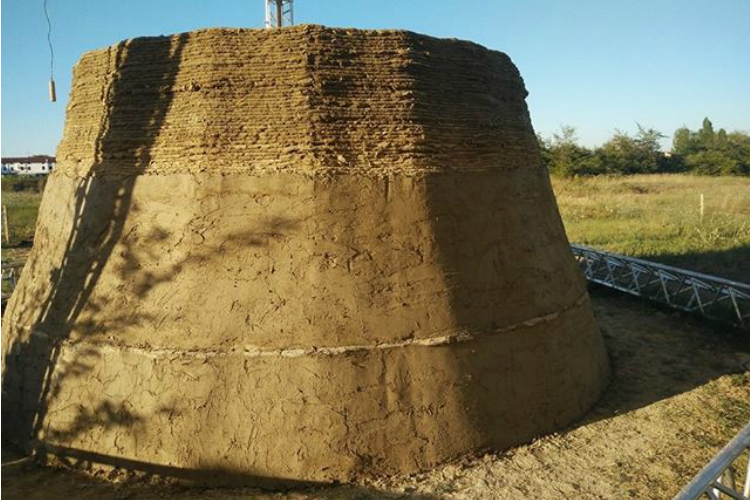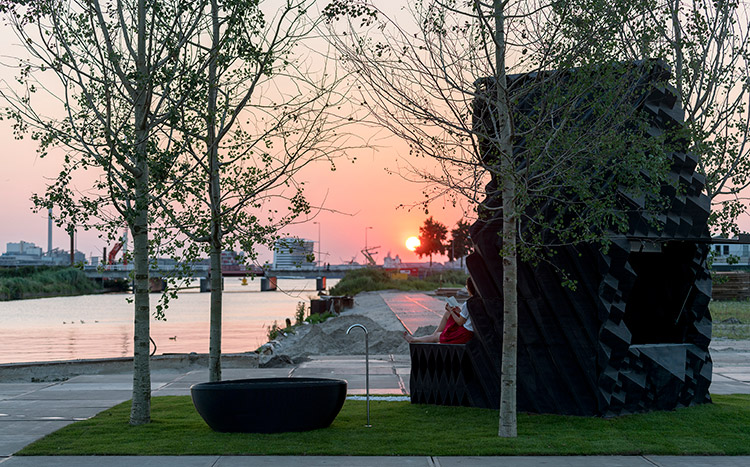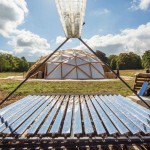3D printed eco-houses, Euro-style
Published 6 September 2016 by Elsa Ferreira
On one side, a house made of rudimentary clay, 3D printed for almost nothing using a giant Italian machine. On the other side, a bio-plastic cabin for rent by the night, 3D printed by Dutch DUS Architects.
The race to design the first sustainable 3D printed house is picking up speed. After the first luxury hotel, complete with jacuzzi, 3D printed in the Philippines in 2015, the technological prowess of Chinese firm Winsun (its village assembled in 24 hours, its five-story building and 1000m2 villa) and contour crafting, a method developed in the U.S. to construct buildings in a single block on a large scale, it’s Europe’s turn to flex its 3D printing muscles in architecture.
Starting with Italy. For now, no doors or windows, but a structure made of clay and mud printed layer by layer. Designed by the company WASP (World’s Advanced Saving Project) this summer, the refuge is the first prototype of a 3D printed house made of straw and earth. Once completed (the construction site is on hold as the team tours festivals and other 3D printing events), the structure will measure 4-meter-high with a 5-meter diameter. Ultimately, the team estimates that these houses could be built within a week by two people for a production cost of 48€: “32€ for energy, 3€ for water, 10€ for the straw, 3€ for gas for the engine.”


In order to finalize this prototype, WASP developed Big Delta, a giant 12-meter-high 3D printer. “You put earth, straw and water into a mixer, then the material is manually fed into the machine,” explains Massimo Moretti, director of WASP. “We are currently studying ways to mechanize this process.” The company, which specializes in research and selling 3D printers, is also working on a solar panel system to supply the energy required for Big Delta’s operation.
Big Delta at work, August 2016:
This construction is the first phase of Shamballa, a technological village entirely dedicated to 3D printing in Massa Lombarda in the Emilie-Romagne region, in order to “experiment with the maker economy, that is to say, our vision of a new economy based on DIY principles,” writes Moretti in an e-mail. The goal is to develop “zero kilometer” housing. “We want to work with low-cost local materials, like earth and fibers, and which consume low energy,” he adds.
WASP is also developing the “Maker Economy Starter Kit”, which will contain the necessary machines to build a self-sufficient eco-friendly village. “In the future, there will be big cities but also maybe small independent villages based on DIY principles. We’re working on building this kind of world,” Moretti declares.
In Amsterdam, a night in an “urban cabin”
Meanwhile in the Netherlands, 3D printed accommodation has become more urban. On August 30, architecture firm DUS announced the opening in Amsterdam of its first “urban cabin” printed in bio-plastic. While their research is more oriented toward temporary emergency housing, the Dutch architects have opened up their “micro home” for short-term rentals—8m2 in biodegradable plastic situated on the canal, with 3D printed bathtub outside (not for the shy).


Printed by KamerMaker (literally “room maker” in Dutch), a 3.5-meter-high printer installed in a container and developed in collaboration with Ultimaker, the used plastic can be shredded and reused for a new design, DUS claims.
Here again, this project is a showcase for DUS Architects, who have been working for the past two years on a 13-room house, also in Amsterdam, destined to become an “innovation hub”. It should be completed by early next year.
Printing a part of the 3D house, DUS, 2014:
More on WASP’s adobe house and DUS’s “micro home”

